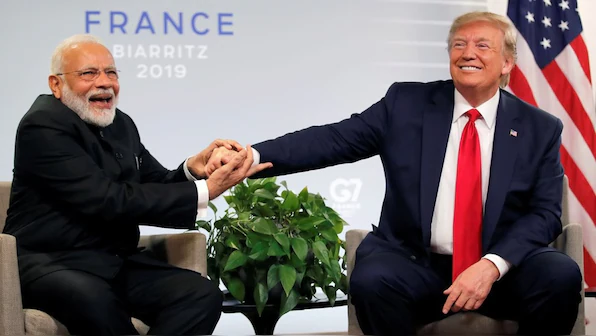
Trump’s Tariff Threats: A Global Concern
Donald Trump’s return to the political spotlight has reignited fears of tariffs and economic disputes worldwide. His aggressive stance on trade policies, particularly targeting countries like India, has raised alarms among policymakers, investors, and businesses. The “fears of Trump” are not just speculation—his past actions and recent rhetoric suggest that major economic shifts could be on the horizon.
India’s Trade Relations Under Scrutiny
Fears of Trump has consistently criticized India’s high import tariffs, particularly on American goods. His statements often highlight what he perceives as an unfair trade imbalance, with India imposing hefty duties on U.S. exports while enjoying relatively lower tariffs on its own exports to the United States.
During his previous tenure, Trump frequently pointed out that Indian tariffs on American products could reach as high as 100-200%. This sparked diplomatic negotiations and trade adjustments, but with a possible return to power in 2024, many believe he could take even more aggressive steps to address this issue.
Tariffs: A Growing Concern for Indian Markets
The United States remains one of India’s most crucial trading partners. Unlike many other countries where India imports more than it exports, the U.S. is one of the few nations where India enjoys a trade surplus. Any increase in tariffs from the U.S. could severely impact India’s stock market, exports, and overall economic stability.
Recently, Trump imposed significant tariffs on:
- Canada – 25%
- Mexico – 25%
- China – 10%
These moves have sparked speculation that India could be next in line for similar measures. Indian industrialists and market analysts are closely monitoring the situation, with financial leaders like Uday Kotak warning that businesses must prepare for potential disruptions.
The Global Response: Countries Fight Back
The impact of Trump’s tariffs is not limited to India. Countries like Canada have already started retaliating by imposing their own tariffs on American goods. Canadian Prime Minister Justin Trudeau publicly criticized Trump’s policies, reminding the world that Canada has stood by the U.S. in global conflicts, yet is still being targeted by harsh trade measures.
In response, a wave of nationalism has surged in Canada, with citizens actively boycotting American products and switching to local alternatives. Supermarkets across the country have seen consumers carefully examining product labels, ensuring they buy only “Made in Canada” goods.
This push for economic self-reliance is a clear sign that nations are prepared to stand up against Trump’s aggressive trade strategies. The question now is: How will India respond?
A New Investment Opportunity Amidst the Uncertainty
While trade tensions create volatility, they also open doors for investors seeking strategic opportunities. The reduction of tariffs on American-made luxury goods presents a lucrative opening for business-minded individuals. Investors can now explore avenues in the premium automobile and motorcycle industries, capitalizing on a market that was previously restricted by high import duties.
For Indian consumers, this shift means better access to high-end foreign brands at more competitive prices. For investors, it signifies a chance to engage with a previously untapped segment of the market.
India’s Strategy Moving Forward
With Prime Minister Modi scheduled to meet Trump in February 2025, trade negotiations will likely be at the top of the agenda. The Indian government has already taken steps to reduce tensions by lowering import duties on select American products. This preemptive move aims to prevent India from becoming the next target of Trump’s tariffs.
However, whether this strategy will be enough remains uncertain. If Trump reinstates his aggressive economic policies, Indian exports to the U.S. could face significant hurdles. Industries reliant on American markets—such as IT services, textiles, and pharmaceuticals—must prepare for potential shifts in trade dynamics.
What This Means for Investors and Businesses
For those involved in trade and commerce, the “fears of Trump” highlight the importance of diversification. Businesses that rely heavily on exports to the U.S. should consider expanding into alternative markets. Additionally, domestic investments in industries that benefit from reduced tariffs could yield significant returns.
Key takeaways for investors include:
- Monitoring trade negotiations between India and the U.S.
- Exploring investment opportunities in industries affected by tariff changes
- Diversifying business strategies to reduce reliance on the American market
| Product Category | India’s Tariff on U.S. Imports | U.S. Tariff on Indian Imports |
|---|---|---|
| Motorcycles (above 800cc) | 50% (Reduced from 100%) | 0% |
| Automobiles | 60% | 2.5% |
| Agricultural Products | 30-50% | 0-10% |
| Medical Devices | 20% | 0% |
| Electronics | 20-30% | 0-5% |
| Textiles & Apparel | 10-20% | 14-32% |
Final Thoughts: Turning Challenges Into Opportunities
While the fears of Trump are driving economic uncertainty, they are also paving the way for new opportunities. Savvy investors and business leaders who can navigate these changes strategically will be best positioned to thrive in the evolving global landscape.
India’s response to Trump’s tariff policies will determine whether it emerges stronger or faces economic setbacks. One thing is certain: the upcoming trade discussions between Modi and Trump will play a crucial role in shaping the future of U.S.-India relations.
For now, investors should stay informed, adapt to changing policies, and seize the opportunities that arise from global trade shifts. The road ahead may be uncertain, but for those willing to take calculated risks, it could lead to substantial rewards.
Future Predictions & Expert Takes
As India takes strategic steps to lower tariffs on American imports, the bigger question remains: What’s next for India’s economy, and how will investors be affected? With global trade tensions on the rise, India’s response to Trump’s policies could open up massive opportunities for foreign and domestic investors.
Will India Become the Next Global Manufacturing Hub?
The reduction in tariffs on American motorcycles and automobiles signals a potential shift in India’s trade policies. If these reductions extend to other industries, India could position itself as a prime destination for global manufacturing.
- Lower tariffs make India more attractive to foreign companies looking for alternative production bases outside China.
- The government’s ‘Make in India’ initiative aligns well with these trade shifts, encouraging companies to establish local plants instead of relying on imports.
- Major tech and automotive giants may reconsider their strategies and move production to India, strengthening the country’s role in global supply chains.

Could Tesla and Harley-Davidson Start Local Production in India?
The possibility of Tesla and Harley-Davidson setting up manufacturing plants in India is growing stronger. India remains a huge potential market for both brands, but high import duties have historically slowed expansion. Now, with tariff reductions, there is a strong incentive for these companies to invest locally rather than rely on imports.
- Tesla’s Expansion: Elon Musk has previously hinted at the possibility of setting up a factory in India if import duties were reduced. With these new developments, a Tesla plant in India seems more feasible than ever.
- Harley-Davidson’s Comeback: The company had once considered scaling down its India operations, but with new trade policies, a shift towards localized production could revive its presence.
How Will Trump’s Next Moves Impact Investors in India?
Investors in India should watch Fears of Trump tariff policies closely. His aggressive stance on international trade could impact key industries like automobiles, tech, and manufacturing. While some sectors may benefit from lower import duties, others could face unpredictable challenges.
| Scenario | Impact on Investors |
|---|---|
| Further tariff cuts by India | Increased foreign investments in local manufacturing |
| Trump imposing higher tariffs on India | Potential short-term market volatility |
| U.S. companies shifting to India | Job creation and stock market growth in sectors like EVs, motorcycles, and electronics |
For Indian investors, these developments create both risks and opportunities. Those who act early by investing in companies benefiting from tariff reductions—such as local automotive and manufacturing firms—could see significant gains in the coming years.
You Might Also Like
- Will the USA Destroy Canada? The Impact of Trade War and Tariffs
- Why Gold Price Increasing in India? What’s Driving the Surge?
- Tax Relief 2025: How New Policies Help the Middle Class Save & Build Wealth
- Gold Analysis: Will Prices Surge? Latest Trends & Market Forecast
Global Impact and Comparison: How Other Countries Have Responded to Trump’s Tariffs
Fears of Trump tariffs have caused a ripple effect across global markets. Countries like Canada, Mexico, and China have each taken unique measures to mitigate the impact on their economies. For instance, Canada imposed a 25% tariff on American products in retaliation, urging consumers to support local products. Similarly, Mexico and China also raised tariffs on U.S. goods, creating significant disruptions in global supply chains.
India, facing similar pressure, may follow suit by imposing counter-tariffs, which could impact trade relations, particularly in the motorcycle industry. The reduced import duties on Harley-Davidson bikes may signal India’s strategic move to soften these impacts while keeping trade channels open.
Here’s a snapshot of how different countries have responded:
| Country | Response to Trump’s Tariffs | Impact on Global Trade |
|---|---|---|
| Canada | Imposed 25% tariffs on U.S. goods | Increased costs for American products in Canada |
| Mexico | Raised tariffs on U.S. imports | Disrupted trade and increased production costs |
| China | Imposed tariffs on U.S. goods, especially agricultural | Impacted U.S. exports, causing a shift in trade routes |
| India | Reduced import duties on U.S. motorcycles (e.g., Harley-Davidson) | Boosted U.S.-India trade but could hurt local manufacturing |
With the recent Fears of Trump tariff imposed yesterday, India might have to adapt quickly, ensuring it remains competitive in the global market while managing domestic interests.

India’s Strategic Vision: A Push for Tesla and Harley-Davidson to Build Locally
India is keen to encourage global giants like Tesla and Harley-Davidson to establish local manufacturing operations within its borders. This strategic move would not only help bypass high import duties but also boost India’s position as a key player in the global automotive and motorcycle markets. By offering favorable policies, reduced tariffs, and infrastructure development, India hopes to become a manufacturing hub for some of the world’s biggest brands.
Why India Wants Local Manufacturing:
- Cost Reduction: Import duties on foreign-made vehicles, including bikes like Harley-Davidson, are steep, often making the end product significantly more expensive for Indian consumers. By encouraging local production, these companies can reduce costs and offer more competitive pricing.
- Boost to Local Economy: Local manufacturing would generate jobs, enhance skills, and contribute to economic growth. With India’s growing middle class and demand for premium bikes and electric vehicles, there’s a massive opportunity for companies like Tesla and Harley-Davidson to tap into the market.
- Green Initiative: Tesla, known for its electric cars, aligns with India’s push towards sustainability. Local production of Tesla’s electric vehicles would help accelerate India’s adoption of green technology, complementing its push for renewable energy sources.
- Strengthening Trade Relations: If these companies choose to set up operations in India, it will not only improve the trade balance but also solidify diplomatic ties between India and the United States, creating mutual growth and stability.
India’s government has already started taking steps in this direction, offering incentives for foreign direct investment (FDI), streamlining manufacturing policies, and supporting infrastructure improvements to attract global manufacturers.
Why India Wants Local Manufacturing:
| Reason | Impact on India | Benefit for Companies |
|---|---|---|
| Cost Reduction | Lower prices for consumers | Competitive pricing in India |
| Local Economic Growth | Job creation, skills development | Expanded market and customer base |
| Green Initiative | Promotes electric vehicles adoption | Aligns with sustainability goals |
| Stronger Relations | Improved trade ties with the U.S. | Enhanced diplomatic and trade relations |



